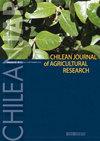Garrido和Mann(1981)对智利南部奶牛草代谢能预测方程的验证
IF 1.7
4区 农林科学
Q2 Agricultural and Biological Sciences
引用次数: 1
摘要
本文章由计算机程序翻译,如有差异,请以英文原文为准。
Validation of grass metabolizable energy prediction equation by Garrido and Mann (1981) for dairy cows in southern Chile
Metabolizable energy (ME) is the most limiting nutrient for milk production in pastoral systems. In Chile, using four wethers and grass cut on six measurement dates, Garrido and Mann (1981) developed an equation to predict grass ME concentration based on content of in vitro digestible organic matter in DM. The application of the Garrido and Mann (1981) equation has been generalized in Chile for all feed ingredients, diets and ruminant species. We hypothesized that ME prediction from this equation has limitations for its use in lactating grass-fed dairy cows. The objective of this study was to validate the ME prediction equation by Garrido and Mann (1981) for lactating grass-fed dairy cows in the autumn and spring seasons. The study was conducted at INIA Remehue (Osorno, Chile) using two sets of eight Holstein Friesian cows, with each group used twice in 21-d experimental periods in autumn and spring, respectively. Fresh grass-only diets with a predominance of perennial ryegrass ( Lolium perenne L.) were supplied through soiling. In the last 5 d of each period, grass ME concentration was measured by subtracting energy lost in feces, urine and methane from ingested gross energy. A weak linear relationship was obtained between the ME determined in trials and ME predicted from the Garrido and Mann (1981) equation (R 2 = 0.266; P = 0.003). The ME prediction equation currently in use is inadequate for lactating grass-fed dairy cows. Therefore, new and improved equations for estimating grass ME specific to dairy cows are needed.
求助全文
通过发布文献求助,成功后即可免费获取论文全文。
去求助
来源期刊
CiteScore
3.00
自引率
11.80%
发文量
60
审稿时长
6 months
期刊介绍:
ChileanJAR publishes original Research Articles, Scientific Notes and Reviews of agriculture, multidisciplinary and agronomy: plant production, plant protection, genetic resources and biotechnology, water management, soil sciences, environment, agricultural economics, and animal production (focused in ruminant feeding). The editorial process is a double-blind peer reviewing, Editorial Office checks format, composition, and completeness, which is a requirement to continue the editorial process. Editorial Committee and Reviewers evaluate relevance and scientific merit of manuscript.

 求助内容:
求助内容: 应助结果提醒方式:
应助结果提醒方式:


